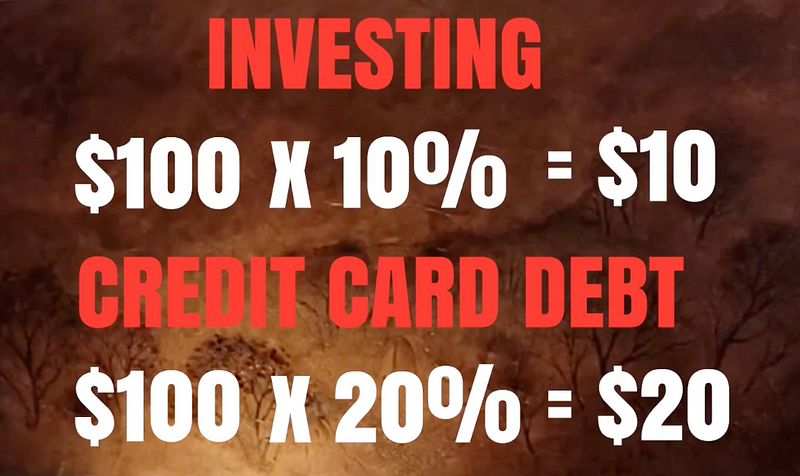- The Moneycessity Newsletter
- Posts
- Don't Start Investing in 2025
Don't Start Investing in 2025
Before you dive into investing in 2025, it's crucial to know when not to invest. This guide reveals three key situations to avoid, helping you build a stronger foundation and make smarter, more confident financial decisions.
Don’t start investing in 2025 — at least, not yet. If you’re not careful, jumping in too soon could hurt you more than it helps you.
Many people hear “start investing early” and think they need to rush in, but investing isn’t a one-size-fits-all solution.
There are specific times when investing might not be the right move, and skipping these steps could leave you worse off.
I’m sharing three key situations where you shouldn’t invest, how to know when you’re ready, and why all three are critical to address first, so make sure to read till the end.
Watch the extended version HERE.
Don’t Invest If You Have High-Interest Debt
The first situation to watch out for is letting the wrong people invest in you. When we invest in the stock market, we can expect an average return of 7–10% per year. Some years might be higher, some lower, and occasionally, we might even lose money. But over time, $100 invested today could grow to $110 next year.
So, what do I mean by the wrong people investing in you? When Natalie and I bought our house, we got a loan from the bank at a 4% interest rate. I’m okay with that because I expect my house to appreciate by more than 4% over time. Plus, I can use the cash I didn’t put into the house to invest in the stock market and potentially earn 7–10%. Losing 4% here but gaining 7–10% there works out in the long run.

What I don’t want is letting credit card companies invest in me. The average credit card interest rate is around 20%, which means they’re getting a guaranteed 20% return if I carry a balance. By paying off my credit card debt, I’m essentially getting a 20% return on that money — something I’d never find in the stock market.
Carrying credit card debt is like having a hole in your boat while trying to row faster to fix the problem. If I invest $100 in the stock market and earn 10%, that’s $10 gained. But if I have $100 in credit card debt at 20%, I lose $20 on that same $100. I’m up $10 but down $20 — it just doesn’t add up.
The average American carries $6,000 in credit card debt, which costs more than $1,200 a year in interest. That’s more than many beginner investors earn on their investments. If you have high-interest debt, paying it off should be your first priority. It’s like locking in a return equal to the interest rate you’re paying. This applies to credit cards, payday loans, car loans, or even student loans — any debt with an interest rate over 5–6%.
Don’t Invest Without an Emergency Fund
Once my debt is under control, there’s another financial priority that Ineed to tackle before investing.
The biggest mistake people make in the stock market is selling when stocks are down. It sounds obvious — don’t buy high and sell low — but life doesn’t always make it that simple.
If all my money is tied up in investments and I face an unexpected expense, like a medical bill or car repair, I’m forced to sell my stocks no matter what the market looks like. That could mean taking a big loss, and it defeats the purpose of investing.
Investing without an emergency fund is like building a castle on quicksand — one emergency, and everything crumbles.
Most experts recommend saving three to six months’ worth of essential expenses. I base this on my job security. If I think I could replace my job quickly, I might save three months’ worth. If finding a new job could take longer, I aim for six months or more.
For me, essentials include rent, food, utilities, my car payment, and my phone bill — anything I need to survive and keep working. Once I have at least three months of these expenses saved, I feel secure enough to start investing.
Don’t Invest If You Don’t Have a Clear Plan
With my debt paid off and an emergency fund in place, there’s one more thing I think about before investing: my goals and timeline.
Investing is powerful over the long term, with average returns of 7–10% over 10, 20, or 30 years. But in the short term, it’s unpredictable. Markets can crash, like in 2008, when investors lost half their money in just two years. Over decades, the market typically recovers, but that doesn’t help if I need the money sooner.
Natalie and I are saving up to have kids in a couple of years. That’s a big expense, and we need to know the money will be there when we need it. If I invest it in the stock market and a crash happens, we might come up short for hospital bills or other essentials.
For short-term goals, I stick to safer options like high-yield savings accounts, CDs, or bonds, which offer guaranteed returns over a shorter timeframe.
Before I invest, I always ask: What am I saving for? Short-term goals like having kids, medium-term goals like buying a house, or long-term goals like retirement? Knowing my timeline and risk tolerance helps me make smarter decisions and avoid gambling with my future.
Once I’ve addressed these three priorities — debt, an emergency fund, and clear goals — I’m ready to invest. But even then, mindset matters as much as planning. Emotional pitfalls can lead to costly mistakes, like selling at the wrong time, so check out THIS VIDEO where I’m sharing the nine mind traps that cause investors to lose money in the stock market.
Cheers!

Reply